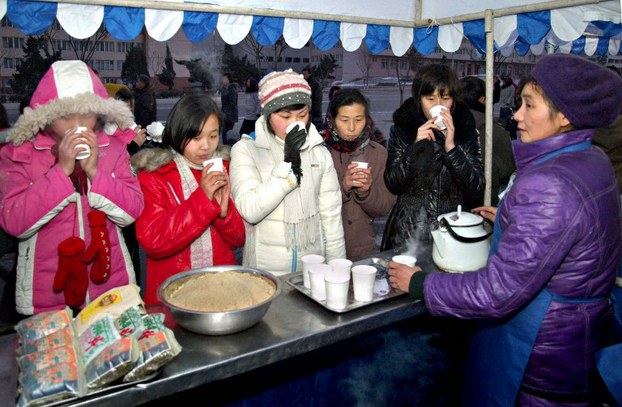A U.N. effort to expand an initiative to provide North Koreans with safe drinking water is being held up by funding and logistics problems, an official says.
More than one-quarter of the people in the nuclear-armed but impoverished nation have no access to safe drinking water, a basic necessity.
The U.N. initiative promotes the use of Gravity Fed Water Systems (GFS), which draw clean water from high up in mountain regions and pipe it down to residents of both urban and rural communities.
The GFS initiative has been primarily funded by the United Nations Children’s Fund (UNICEF) and constructed by North Koreans.
Geoffrey Keele, a spokesperson for UNICEF in Beijing, told RFA’s Korean Service that his organization had completed feasibility studies for expanding the GFS initiative in 14 villages in North and South Hamgyong, North Hwanghae, and North Pyongan provinces, but that more funding is needed to push ahead with construction.
More than one-quarter of the people in the nuclear-armed but impoverished nation have no access to safe drinking water, a basic necessity.
The U.N. initiative promotes the use of Gravity Fed Water Systems (GFS), which draw clean water from high up in mountain regions and pipe it down to residents of both urban and rural communities.
The GFS initiative has been primarily funded by the United Nations Children’s Fund (UNICEF) and constructed by North Koreans.
Geoffrey Keele, a spokesperson for UNICEF in Beijing, told RFA’s Korean Service that his organization had completed feasibility studies for expanding the GFS initiative in 14 villages in North and South Hamgyong, North Hwanghae, and North Pyongan provinces, but that more funding is needed to push ahead with construction.
“Currently, we are lacking the necessary funding to support more GFS projects and there continue to be delays in receiving critical supplies from offshore locations,” he said.
“There is also a considerable challenge in relation to local transportation due to a lack of trucking companies.”
Keele said that GFS initiative had been completed in three urban and four rural areas, including Tosan, Hamju, and Hyangsan county towns, and Puksinhyon, Rimhung, Unbong, and Chusang villages.
He said that more GFS projects are ongoing in Jangyon, Sinpyong, Sudong, Ichon, Sepo, Unjon, Kumya, Kilju, and Pihyon counties, as well as in 11 villages in Kangwon, North Pyongan, and North Hwanghae provinces.
According to a report issued by UNICEF last summer, around 100,000 people, including some 7,000 children under the age of five, had access to safe water in 2011 following the completion of nine GFS projects.
But it said that the coverage represented less than 2 percent of the 5.28 million people in North Korea that still need access to clean water—a staggering figure given the North’s population of just over 24 million.
In 2011, the report said, the nine completed GFS projects provided clean water to all targeted institutions in the areas where the systems had been constructed, including 14 health facilities, 17 primary schools and secondary schools, 13 nurseries, and 14 kindergartens.
An earlier pilot program in ten focus counties from 2007-2009 supplied more than 228,000 people with clean water.
Water challenges
Keele said that UNICEF partners with the Ministry of City Management and with local communities to bring GFS projects to North Korea, which despite a piped distribution network, suffers from poor delivery of water due to old systems and a shortage of electricity needed to pump water to homes.
“Key supplies for operating and maintaining piped water systems are now in short supply, including pumps, spare parts, pipes and water treatment chemicals,” he said.
“All of the old pump-based facilities use rivers or other low-lying water sources, which are more susceptible to contamination from human and industrial waste. So in many cases the water that does reach people is of poor quality.”
According to UNICEF, diarrhea is the number one cause of child mortality in North Korea and, together with pneumonia, affects large numbers of children in the country.
“Both of these illnesses can result from insufficient water for proper hygiene or through contaminated water caused by the deterioration of the country’s water supply infrastructure,” Keele said.
He said that GFS is a simple, cost effective, and environmentally sound means of providing clean water to North Koreans by taking fresh water from the country’s abundant mountain ranges and filtering it through natural sand and gravel purification ponds.
When the water is free of impurities, he said, it is channeled through a series of PVC pipes where gravity transports the water down to a community’s homes, schools, and hospitals, without the need for electricity.
According to UNICEF, the average cost to design and construct a standard GFS in a medium-sized county town of around 20,000 people is about U.S. $500,000. It says the technology is low-maintenance and requires relatively low running costs.
The project is expected to help North Korea achieve several of its Millennium Development Goals in 2015, including a reduction in child mortality, improvements in maternal health, and a reduction in malnutrition.

No comments:
Post a Comment